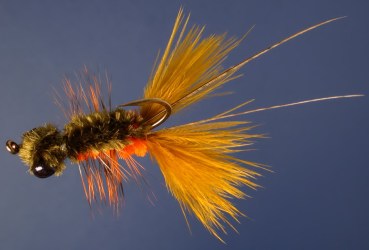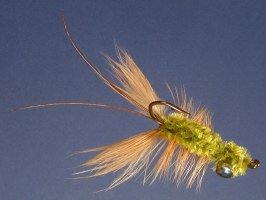Invicta Flies - Cumberland Crayfish
An effective, durable crayfish imitation that is especially productive on smallmouth bass and larger sunfish. The marabou pincers spread to display a defensive position, then fold up and undulate as the fly is stripped in short, pulsing busts like a fleeing crayfish. Use colors that match local naturals, as well as attractors like black, or with an orange thorax. To fish, simply let the fly settle to the bottom, strip the line several times to make the fly "swim," then let it settle again. Use a line appropriate to the waters you intend to fish to get the fly on the bottom.
 |
 |
Hook: Mustad 9672, #6-8
Thread: Uni-Thread 6/0, color to match back
Pincers: marabou, divided and wrapped
Antennae: ringneck pheasant tail fibers
Thorax: medium chenille
Legs: saddle hackle, palmered through thorax
Back & Abdomen: medium chenille
Curled Tail: hourglass eyes wrapped with chenille
1) Secure hourglass eyes to top of hook shank two to two and a half hook eye widths behind eye. Apply a drop of Super Glue or Zap-A-Gap to the thread wraps. Paint lead eyes in a matching color. Brass (nickel-plated, gold, etc.) can either be painted or left as is for a little flash.
2) Bring thread to hook bend. Tie in marabou for pincers. To prepare, even up the fiber tips and trim bundles from an entire feather, then align bundles. In general use about the same amount you might use for the tail of a Wooly Bugger. Tie in on top of the shank, length equal to the hook shank. Divide into two equal bundles and figure eight wrap, taking five or six turns of thread around each bundle. The finished pincers should stand out from the shank about 45 degrees, lined up with the hook shank... pincers out of line, either pointing up or down, may cause the fly to fish upside-down or on its side. Cement the thread wraps at the base of each pincer.
3) Tie in two ringneck pheasant tail fibers on underside of hook, one on each side, at bend of hook, the tips extending about a hook gap beyond the pincers.
4) Tie in tag end of chenille that is to be the back color at bend on underside of hook, stripping the last 1/4 inch to tie this in by the core. Tie in two more smaller sections of the same color chenille in the same manner, one on each side of the first on the underside of the hook. The excess of all three sections should extend past the bend of the hook.
5) Tie in belly color chenille at bend on the top of the hook shank. Again, expose the core and secure the chenille by lashing this to the shank.
6) Trim a few fibers from each side of the butt end of a saddle feather. The feather should have fibers which shoul be about one and a half times the hook gap in length. Tie in by the butt end, convex side forward, about one chenille strand width in front of the bend, by the butt end. Bring the thread 2/3 the way up the hook shank (should be behind lead eyes a distance equal to the width of the eyes). NOTE: for natural imitations, a dyed grizzly saddle is ideal
7) Take one full turn of the belly chenille behind the hackle, then continue in front of the hackle to the tying thread. Tie off and clip.
8) Palmer wrap the chenille forward to tying thread, taking one full turn first, then tightly working the feather through the chenille to the tying thread. Tie off and clip the excess.
9) Turn hook over or rotate the vise. Bring the longer, middle, "back" chenille strand over what is now the top. Twist the chenille tightly, pull down to divide the palmered hackle, then tie down with the thread. Do not clip. Reapeat for the two smaller strands, and clip the excess from these. to form the back.
10) Wind remaining chenille forward to lead eyes.Bring chenille up on near side of hook behind lead, then over and down in front of lead on far side of hook. Take one full turn, then go over the shank and down behind the eyese on the far side, then up in front of the eyes on the near side. Take a half turn to bring the chenille down on the far side, then come up on the near side behind the eyes. Tie off behind the eyes and whip finish. Cement the thread wraps with a fine needle.
11) Clip the hackle fibers from the bottom of the fly so you end up only with fibers protruding mostly out to the sides.

Softshell olive version.